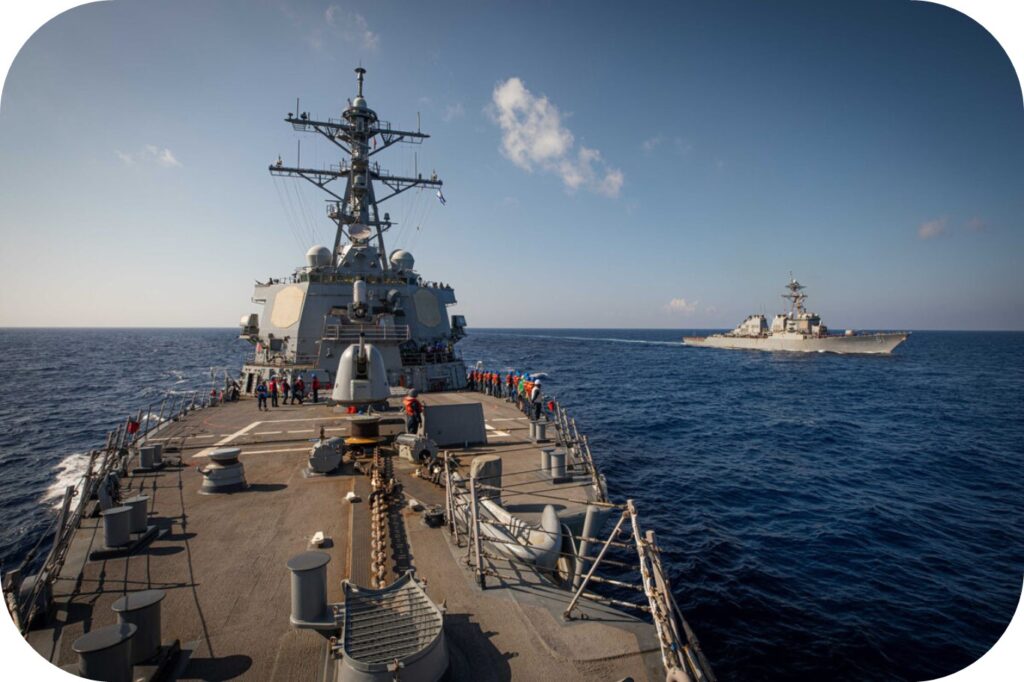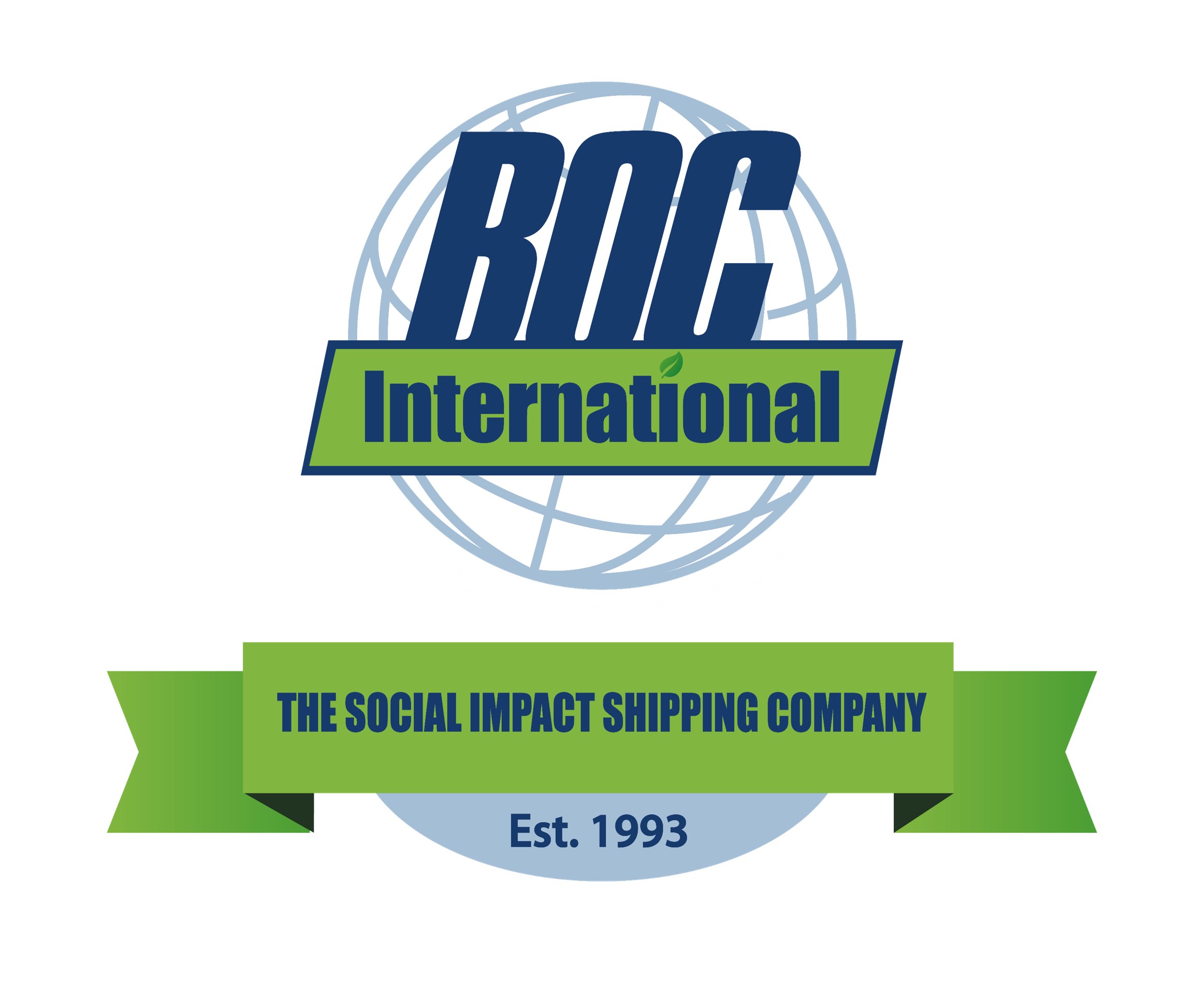
Suez Canal Attacks & Updated Trans Pacific Sailing Schedules
Viewpoint: What Red Sea attacks mean for shipping
Weekend assault on commercial vessels could have impact on global trade.
Lori Ann LaRocco. Monday, December 04, 2023 – FreightWaves.com

The guided missile destroyers USS Carney, left, and USS Ramage sail together in the eastern Mediterranean Sea on Oct. 16. (Photo: Navy Petty Officer 2nd Class Aaron Lau/U.S. Navy)
Geopolitical tensions and attacks in the Red Sea have increased since the commencement of the Israel-Hamas conflict. Iran-backed Houthi rebels have focused their attacks in the Red Sea and Gulf of Aden on any merchant shipping that they believe is affiliated with Israel. Following this weekend’s four attacks on three civilian ships near Yemen, the U.S. Navy destroyer USS Carney responded, thrusting the security of trade into the spotlight.
The Red Sea is the superhighway to the Suez Canal. Judah Levine, Freightos’ head of research, said the Suez Canal sees 50-60 vessels transiting each day for about 19,000 each year, including about 30% of global container traffic.
The Suez has seen an increase in U.S. energy and grain exports as well as U.S. eastbound container imports as the Panama Canal drought restrictions are constricting the flow of trade.
The biggest source of worry is the timeliness of the Houthis vessel data. A Houthi military spokesperson confirmed it targeted a container ship with a drone and another bulk grain vessel because it claimed both vessels were linked to Israel. One, however, was not. Houthis reportedly had outdated information, according to maritime security firm Ambrey.
According to the U.S. Central Command (Centcom), the bulk vessel — Number 9 — that was attacked Sunday is owned by U.K.-based Castle Harbour and operated by U.K.-based Bernhard Schulte Shipmanagement (BSM) and not connected to Israel. The operator appeared to change from Zim in November 2021, according to Ambrey. MarineTraffic shows the vessel left Singapore on Nov. 22 and was slated to go through the Suez Canal this Wednesday.
Ambrey has advised company security officers to assess whether their vessels were owned or managed by an Israel-affiliated company within the last year. But the Israel connection seems to go to the individual level.
Centcom reported that another one of the four vessels attacked was the Bahamas-flagged Unity Explorer. While owned and operated in the U.K., the Israel connection is among its management. Unity Maritime is controlled by Danny Ungar, the son of Israeli shipping businessman Abraham “Rami” Ungar. In November, Ungar’s shipping company, Ray Car Carriers, had its 5,100-unit car carrier Galaxy Leader hijacked by the Houthis.
Unity Explorer is a dry bulk ship that was loaded with grain from the U.S. Cargill grain elevator and transported from the Gulf of Mexico. The vessel left Nov. 2 bound for Singapore and traveled through the Suez Canal approximately six days ago, according to MarineTraffic.
In a statement following the attacks, Centcom said, “These attacks represent a direct threat to international commerce and maritime security. They have jeopardized the lives of international crews representing multiple countries around the world. We also have every reason to believe that these attacks, while launched by the Houthis in Yemen, are fully enabled by Iran. The United States will consider all appropriate responses in full coordination with its international allies and partners.”
But given the misidentification by Houthis of the Number 9, should any ocean carrier that was once linked to Israel consider itself a target because the militants may be working with old information? Does this also mean we could be looking at a war risk premium for vessels traversing the Red Sea and Gulf of Aden if we see more of these attacks?
What this means for trade
War stokes inflation and these attacks can only add to the threat of more war risk premiums. There is currently a war risk premium for vessels going to Israel. In light of the latest attacks and the misidentification of a vessel by Houthis, we may see the war risk premium expanded throughout the Red Sea and Gulf of Aden. This will only add to the inflationary pressures of using this trade route.
The Suez Canal Authority recently announced an increase of 5%-15% in transit fees, taking advantage of the increase in vessel traffic as more ocean carriers avoid the Panama Canal.
“As we saw in the Black Sea, continued attacks on maritime vessels may lead insurance companies to initiate a ‘war risk’ premium for vessels transiting the Red Sea and the shipping lanes south of Yemen,” said Alan Baer, CEO of OL USA. “If initiated, carriers may have no choice but to pass this additional cost onto exporters and importers the world over.”
When it comes to trade, it has to flow regardless of the situation. Operators will have vessels change course for safety.
Levine said there have been a handful of examples of Israeli-owned vessels diverting from passage through the Suez Canal and instead sailing around Africa’s west coast and Cape of Good Hope.
“This includes two car carriers, two container vessels operated by Danish carrier Maersk and at least one container vessel by Israel’s Zim Lines,” he explained. “For ships heading to Israel from Asia, the route around Africa is significantly longer — about 7,000 nautical miles and 10-14 days — than via the Suez Canal. This route also incurs higher fuel costs but avoids Suez Canal fees, which are between $400,000-$700,000 per transit and are set to increase by 15% in January 2024.”
Freightos data shows rates from some Chinese origins to Israel have climbed between 16% and 36%.
“This is suggesting that the war is leading to higher costs for carriers and higher prices for their customers,” Levine said.
To mitigate risks, some Israeli ports are closed because of missiles being launched in the area. For those carriers that cannot find war risk insurance, the Israeli government is offering supplemental insurance. This is nothing new, Israel has offered it for years. The Ukrainian government has also offered war risk insurance for vessels that may not be able to secure the extra coverage.
Levine said Zim is alone among the carriers in introducing a war risk insurance premium of between $20 and $100 per container since the start of the war.
ZIM ZXB: add 2 sailing changes rotation from Panama to Cape of Good Hope (or Suez)
| SVC | Vessel Name / Voyage | ETA | Port | Status | |
| ZXB | ZIM Savannah 20E | 1-Jan-24 | Baltimore | via the Cape of Good Hope | PKL-HCM-HPH-YAM-KAO-SHA-BAL-NFK-NYC-BOS |
| ZXB | ZIM AMERICA 18E | 7-Jan-24 | Baltimore | via the Cape of Good Hope | PKL-HCM-HPH-YAM-KAO-SHA-BAL-NFK-NYC-BOS |
| ZXB | ZIM Coral 1E | 14-Jan-24 | Baltimore | via Suez or Cape of Good Hope | KAO-YAN-HPH-HCM-BAL-NFK-NYC-BOS |
| ZXB | ZIM Emerald 1E | 27-Jan-24 | Baltimore | via the Cape of Good Hope | HPH-KAO-YAN-HCM-BAL-NFK-NYC-BOS |
Ocean Alliance: add 2 sailing via Suez, ETA is 3-5 days later, not too bad
| SVC | Vessel Name / Voyage | ETD | Port | Status | |
| AWE4 | COSCO SHIPPING AZALEA 024E | 2-Dec-23 | Shanghai | switch via Suez Canal | YAN-HKG-XMN-SHA-NYC-SAV-CHS |
| GME | OOCL UTAH 067E | 2-Dec-23 | Hong Kong | switch via Suez Canal | SHA-NBO-XMN-YAN-HKG-HOU-MOB-TPA |
| AWE4 | COSCO HARMONY 075E | 14-Dec-23 | Shanghai | switch via Suez Canal | YAN-HKG-XMN-SHA-NYC-SAV-CHS |
| GME | COSCO MALAYSIA 097E | 10-Dec-23 | Yantian | switch via Suez Canal | SHA-NBO-XMN-YAN-HOU-MOB-TPA |
The Alliance: all Dec vessel changes to Suez routing
| SVC | Vessel Name / Voyage | ETD | Port | Status | |
| EC1 | MADRID EXPRESS V.016E | 27-nov-23 | Pusan, KR | switch via Suez Canal | KAO-YAN-SHA-NBO-BUS-NYC-NFK-CHS-SAV |
| EC1 | BASLE EXPRESS V.048E | 3-Dec-23 | Pusan, KR | switch via Suez Canal | KAO-YAN-XMN-SHA-NBO-BUS-NYC-NFK-CHS-SAV |
| EC1 | DORTMUND EXPRESS V.051E | 8-Dec-23 | Pusan, KR | switch via Suez Canal | KAO-YAN-XMN-SHA-NBO-BUS-NYC-NFK-CHS-SAV |
| EC1 | ULSAN EXPRESS V.045E | 14-Dec-23 | Pusan, KR | switch via Suez Canal | KAO-YAN-XMN-SHA-NBO-BUS-NYC-NFK-CHS-SAV |
| EC2 | AL QIBLA EXPRESS V.030E | 27-nov-23 | Pusan, KR | switch via Suez Canal | TAO-YAN-NBO-SHA-BUS-SAV-CHS-WIL-NFK |
| EC2 | NEW YORK EXPRESS V.030E | 2-Dec-23 | Pusan, KR | switch via Suez Canal | TAO-NBO-SHA-BUS-YAN-SAV-CHS-WIL-NFK |
| EC2 | AL RIFFA V.025E | 8-Dec-23 | Pusan, KR | switch via Suez Canal | TAO-NBO-SHA-BUS-YAN-SAV-CHS-WIL-NFK |
| EC6 | EVER SMILE V.114E | 28-nov-23 | Pusan, KR | switch via Suez Canal | KAO-HKG-YAN-NBO-SHA-HOU-MOB |
| EC6 | MOL CELEBRATION V.094E | 29-nov-23 | Pusan, KR | switch via Suez Canal | KAO-HKG-YAN-NBO-SHA-HOU-MOB |
| EC6 | MOL COURAGE V.056E | 5-Dec-23 | Pusan, KR | switch via Suez Canal | KAO-HKG-YAN-NBO-SHA-HOU-MOB |
| EC1 | AIN SNAN EXPRESS 031E | 20-Dec-23 | Pusan, KR | switch via Suez Canal | KAO-YAN-XMN-SHA-NBO-BUS-NYC-NFK-CHS-SAV |
| EC1 | JEBEL ALI 027E | 30-Dec-23 | Pusan, KR | switch via Suez Canal | KAO-YAN-XMN-SHA-NBO-BUS-NYC-NFK-CHS-SAV |
| EC1 | HYUNDAI HOPE 0053E | 14-Jan-23 | Pusan, KR | switch via Suez Canal | KAO-YAN-XMN-SHA-NBO-BUS-NYC-NFK-CHS-SAV |
| EC1 | HYUNDAI VICTORY 0051E | 22-Jan-23 | Pusan, KR | switch via Suez Canal | KAO-YAN-XMN-SHA-NBO-BUS-NYC-NFK-CHS-SAV |
| EC2 | ESSEN EXPRESS 0046E | 14-Dec-23 | Pusan, KR | switch via Suez Canal | TAO-NBO-SHA-BUS-YAN-SAV-CHS-WIL-NFK |
| EC2 | TAYMA EXPRESS 0029E | 23-Dec-23 | Pusan, KR | switch via Suez Canal | TAO-NBO-SHA-BUS-YAN-SAV-CHS-WIL-NFK |
| EC2 | ALULA EXPRESS 0031E | 30-Dec-23 | Pusan, KR | switch via Suez Canal | TAO-NBO-SHA-BUS-YAN-SAV-CHS-WIL-NFK |
| EC2 | SOUTHAMPTON EXPRESS 0038E | 10-Jan-24 | Pusan, KR | switch via Suez Canal | TAO-NBO-SHA-BUS-YAN-SAV-CHS-WIL-NFK |
| EC6 | ONE MISSION 0071E | 13-Dec-23 | Pusan, KR | switch via Suez Canal | KAO-HKG-YAN-NBO-SHA-HOU-MOB |
| EC6 | ONE CONTINUITY 0066E | 19-Dec-23 | Pusan, KR | switch via Suez Canal | KAO-HKG-YAN-NBO-SHA-HOU-MOB |
| EC6 | ONE COSMOS 0095E | 25-Dec-23 | Pusan, KR | switch via Suez Canal | KAO-HKG-YAN-NBO-SHA-HOU-MOB |
| EC6 | EVER SAFETY 0111E | 2-Jan-24 | Pusan, KR | switch via Suez Canal | KAO-HKG-YAN-NBO-SHA-HOU-MOB |

